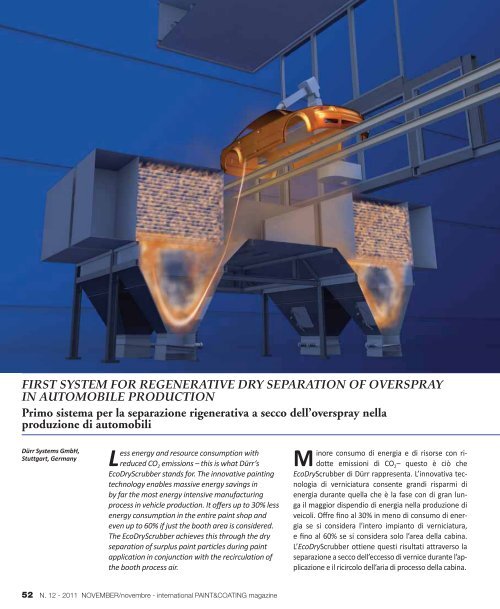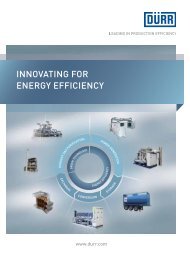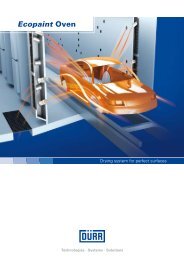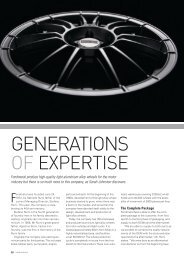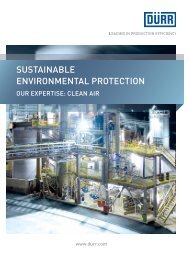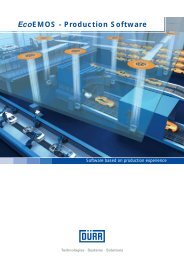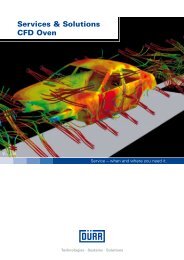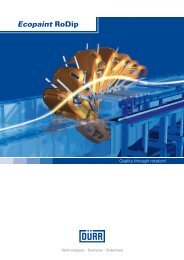DURR ECOdry Scrubber - IPCM novembre 2011.pdf
DURR ECOdry Scrubber - IPCM novembre 2011.pdf
DURR ECOdry Scrubber - IPCM novembre 2011.pdf
You also want an ePaper? Increase the reach of your titles
YUMPU automatically turns print PDFs into web optimized ePapers that Google loves.
Manca foto<br />
d’apertura<br />
FIRST SYSTEM FOR REGENERATIVE DRY SEPARATION OF OVERSPRAY<br />
IN AUTOMOBILE PRODUCTION<br />
Primo sistema per la separazione rigenerativa a secco dell’overspray nella<br />
produzione di automobili<br />
Dürr Systems GmbH,<br />
Stuttgart, Germany<br />
ess energy and resource consumption with<br />
Lreduced CO 2 emissions – this is what Dürr’s<br />
EcoDry<strong>Scrubber</strong> stands for. The innovative painting<br />
technology enables massive energy savings in<br />
by far the most energy intensive manufacturing<br />
process in vehicle production. It offers up to 30% less<br />
energy consumption in the entire paint shop and<br />
even up to 60% if just the booth area is considered.<br />
The EcoDry<strong>Scrubber</strong> achieves this through the dry<br />
separation of surplus paint particles during paint<br />
application in conjunction with the recirculation of<br />
the booth process air.<br />
Minore consumo di energia e di risorse con ridotte<br />
emissioni di CO 2 – questo è ciò che<br />
EcoDry<strong>Scrubber</strong> di Dürr rappresenta. L’innovativa tecnologia<br />
di verniciatura consente grandi risparmi di<br />
energia durante quella che è la fase con di gran lunga<br />
il maggior dispendio di energia nella produzione di<br />
veicoli. Offre fino al 30% in meno di consumo di energia<br />
se si considera l’intero impianto di verniciatura,<br />
e fino al 60% se si considera solo l’area della cabina.<br />
L’EcoDry<strong>Scrubber</strong> ottiene questi risultati attraverso la<br />
separazione a secco dell’eccesso di vernice durante l’applicazione<br />
e il ricircolo dell’aria di processo della cabina.<br />
52 N. 12 - 2011 NOVEMBER/<strong>novembre</strong> - international PAINT&COATING magazine
INNOVATIONS: PRESENT&FUTURE<br />
The Status Quo<br />
When applying wet paints the efficiency varies<br />
depending on the level of automation. In manual<br />
painting 20% of the material reaches the body, while<br />
with automated exterior painting it is 85%. In the<br />
conventional painting process the rest of the paint,<br />
known as overspray, is carried into the lower section<br />
of the spray booth using downward flowing process<br />
air where it binds with water using special Venturi<br />
tubes. The booth process air is drawn off as, through<br />
contact with water it absorbs too much moisture for<br />
it to be re-used, and it also contains paint particle<br />
residues. The paint sludge resulting from the<br />
overspray mixed with water has to be disposed of as<br />
hazardous waste.<br />
The Idea<br />
The starting point for Dürr was to generate cost per<br />
unit advantages for the customer through reduced<br />
energy use. Eliminating the standard wet separation<br />
of excess paint particles that do not adhere to the<br />
car body surface means that fresh water is no longer<br />
required for paint separation. This in turn leads to<br />
the possibility of direct recirculation of the booth<br />
air since it does not accumulate any moisture.<br />
Recirculation reduces the energy required for air<br />
treatment significantly compared to conventional<br />
spray booths. This elimination of fresh water and<br />
the partial addition of fresh air leads to meaningful<br />
improvements in energy consumption and in CO 2 and<br />
paint particle emissions.<br />
Already at the beginning of 2005 the product<br />
developers at Dürr had the first thoughts about this<br />
system which is fully in fashion today. Particular<br />
challenges existed with the issues of complete<br />
automation, precoating and cleaning of the<br />
filters, as well as discharge and refilling of the<br />
precoat material. Then, after about two years of<br />
development time the Dürr pilot plant in Bietigheim<br />
started its operation in April 2007: it has already put<br />
in over 1,500 hours of operation to date.<br />
The Technology<br />
For dry separation Dürr replaced water with<br />
powdered limestone as a bonding agent. This<br />
precoat material comes from silos or big-bag stations<br />
in the separation process. The dry filter modules<br />
consist of process-optimized filter elements which<br />
regenerate automatically during operation and can<br />
Lo status quo<br />
Quando si applica vernice liquida, l’efficienza varia a seconda<br />
del livello di automazione. Nella verniciatura manuale<br />
il 20% del materiale raggiunge la scocca, mentre<br />
con la verniciatura automatica esterna è l’ 85%. Nel processo<br />
di verniciatura tradizionale l’eccesso di vernice, conosciuto<br />
come overspray, è convogliato nella parte più<br />
bassa della cabina di verniciatura tramite l’aria di processo;<br />
questa fluisce verso il basso e qui si unisce all’acqua<br />
utilizzando speciali tubi Venturi. L’aria di processo della cabina<br />
è poi espulsa dal momento che, a causa del contatto<br />
con l’acqua, assorbe troppa umidità per essere riutilizzata,<br />
e inoltre contiene residui di vernice. I fanghi di vernice<br />
che risultano dall’overspray miscelato con l’acqua devono<br />
essere smaltiti come rifiuti pericolosi.<br />
L’idea<br />
Il punto di partenza per Dürr era creare vantaggi di<br />
costo per unità al cliente attraverso la riduzione del<br />
consumo di energia. Eliminando la separazione umida<br />
tradizionale della vernice in eccesso che non aderisce<br />
alla superficie della scocca dell’auto significa che<br />
non si ha più la necessità di acqua dolce per la separazione<br />
della vernice. Al contrario questo consente<br />
il ricircolo diretto dell’aria della cabina siccome essa<br />
non accumula più alcuna umidità. Il ricircolo riduce<br />
in modo significativo l’energia richiesta per il trattamento<br />
dell’aria, se comparata alle cabine tradizionali<br />
di spruzzatura. L’eliminazione dell’acqua dolce e la<br />
parziale aggiunta di aria nuova porta importanti miglioramenti<br />
nel consumo di energia e nelle emissioni<br />
di CO 2 e di particelle di vernice.<br />
Già all’inizio del 2005 gli sviluppatori del prodotto c/o<br />
Dürr ebbero la prima idea riguardo a questo sistema,<br />
oggi molto di moda. Il tema dell’automazione completa,<br />
il precoating e la pulizia dei filtri, così come lo<br />
scarico e il ricarico del materiale di precoat rappresentavano<br />
delle vere e proprie sfide. Dopo circa due<br />
anni di sviluppo, l’impianto pilota Dürr a Bietigheim<br />
iniziò a funzionare nell’aprile del 2007 e oggi funziona<br />
già da oltre 1.500 ore.<br />
La tecnologia<br />
Per la separazione a secco Dürr ha sostituito l’acqua con<br />
calcare polveroso come agente legante. Questo materiale<br />
di precoat arriva al processo di separazione da silos o centrali<br />
big-bag. I moduli di filtrazione a secco consistono di<br />
elementi filtranti ottimizzati per il processo che si rigenerano<br />
automaticamente durante il funzionamento e possono<br />
international PAINT&COATING magazine - NOVEMBER/<strong>novembre</strong> 2011 - N. 12 53
First System for Regenerative Dry Separation of Overspray in Automobile Production<br />
be expected to have a lifespan of 3 years or more.<br />
The cleaning process achieves a filtration of nearly<br />
100% - additional filtration of the recirculated air is<br />
not necessary.<br />
With the constant flow of the air management<br />
system, which usually needs a fresh air supply of 5<br />
to 20%, the wet overspray particles are carried from<br />
the application area into the modular filter box. The<br />
downward air speed of about 0.3 meters per second<br />
accelerates through a constriction in the booth floor<br />
to about 5 meters per second. This suction prevents<br />
the backflow of precoat particles from the filter<br />
module into the booth. The separation takes place on<br />
the surface of the filters and then the recirculated air<br />
is fed back into the supply as clean air.<br />
The precoat material is delivered to the filter module<br />
up to an optimum fill level from the big-bag.<br />
Air nozzles blow the powdered limestone above the<br />
hopper base. The swirling material circulates with the<br />
inflowing air from the application area, thus allowing<br />
complete circulation and uniform coating of all filter<br />
elements. The air is pulled through every filter element<br />
towards the clean air side. The precoat material in the<br />
air flow deposits itself in a complete layer over the entire<br />
filter element surface and hopper walls.<br />
This prevents any direct contact of the wet overspray<br />
with the filters and the inner surface of the filter module.<br />
The paint particles adhere to the precoat layer until<br />
the filter surface is covered with them. This leads to<br />
an increase in air resistance through the filter and<br />
once the maximum pressure differential is reached,<br />
the filter cake is blown off the filter. The filter element<br />
is back-flushed with clean compressed air for a<br />
quarter of a second to dust off the used precoat<br />
material. This dusting off takes place separately for<br />
every filter element and is repeated every 25 minutes<br />
on average. This guarantees constant pressure<br />
conditions and a constant air budget.<br />
Once the filter cake is blown off the filter module<br />
the contaminated precoat material falls into the<br />
hopper and remains within the process until a certain<br />
saturation point is reached. When this point is<br />
reached the used up precoat material is removed by<br />
suction and the hopper is automatically refilled with<br />
fresh precoat material.<br />
The EcoDry<strong>Scrubber</strong> air recirculation system is<br />
designed for fully automated spray booths with<br />
painting robots. The residual dust content after<br />
filtration is less than 0.1 mg/ m 3 . This nearly 100 %<br />
avere una durata fino a tre anni o più. Il processo di pulizia<br />
ottiene una filtrazione vicina al 100%: non è necessaria<br />
una filtrazione aggiuntiva dell’aria di ricircolazione.<br />
Con il flusso costante del sistema di gestione dell’aria, che<br />
normalmente necessita di una alimentazione di aria pulita<br />
dal 5 al 20%, le particelle di overspray umido sono trasportate<br />
dall’area di applicazione al filtro modulare. La velocità<br />
di circa 0,3 metri al secondo dell’aria discendente accelera,<br />
a causa della compressione verso il fondo della cabina,<br />
a circa 5 metri al secondo. Questa aspirazione previene il<br />
riflusso di particelle di precoat dal modulo filtrante alla cabina.<br />
La separazione avviene sulla superficie dei filtri dopodichè<br />
l’aria ricircolata è rimandata al sistema di alimentazione<br />
come aria pulita.<br />
Il materiale di precoat è inviato dal big-bag al modulo di<br />
filtrazione fino a raggiungere un livello ottimale di riempimento.<br />
Gli ugelli d’aria soffiano il calcare polveroso sopra la<br />
base della tramoggia. Il materiale turbinante circola insieme<br />
all’afflusso d’aria proveniente dall’area di applicazione,<br />
e consente così la circolazione completa e il rivestimento<br />
uniforme di tutti gli elementi filtranti. L’aria è spinta attraverso<br />
ogni elemento filtrante verso il lato con aria pulita. Il<br />
materiale di precoat contenuto nel flusso d’aria si deposita<br />
in uno strato completo sopra l’intera superficie dell’elemento<br />
filtrante e sulle pareti della tramoggia. Questo evita<br />
qualsiasi contatto diretto dell’overspray umido con i filtri e<br />
con la superficie interna del modulo filtrante.<br />
Le particelle di vernice aderiscono allo strato di precoat fino<br />
a coprire tutta la superficie del filtro. Ciò conduce a un<br />
aumento della resistenza dell’aria attraverso il filtro ed una<br />
volta raggiunto il differenziale massimo di pressione l’incrostazione<br />
del filtro è soffiata via. L’elemento filtrante è poi<br />
risciacquato di nuovo con aria compressa pulita per 15 secondi<br />
onde soffiare via il materiale di precoat usato. Questa<br />
soffiatura avviene separatamente per ogni elemento<br />
filtrante e si ripete mediamente ogni 25 minuti. Questo<br />
garantisce condizione di pressione costante e un afflusso<br />
d’aria costante.<br />
Una volta che l’incrostazione del filtro è soffiata via dal modulo<br />
filtrante il materiale di precoat contaminato ricade<br />
nella tramoggia e rimane all’interno del processo fino a che<br />
non si raggiunge un certo punto di saturazione. Quando<br />
questo punto è raggiunto il materiale di precoat utilizzato è<br />
rimosso tramite aspirazione e la tramoggia viene automaticamente<br />
ricaricata con materiale di precoat nuovo.<br />
Il sistema di ri-circolazione dell’aria EcoDry<strong>Scrubber</strong> è progettato<br />
per cabine di verniciatura completamente automatiche<br />
con robot di verniciatura. Il contenuto residuo di polvere<br />
dopo la filtrazione è inferiore a 0,1 mg/ m 3 . Questo tasso<br />
54 N. 12 - 2011 NOVEMBER/<strong>novembre</strong> - international PAINT&COATING magazine
INNOVATIONS: PRESENT&FUTURE<br />
filtration rate allows direct air recirculation without<br />
additional filtration and meets HEPA 12 standards.<br />
This makes possible a new booth concept with smaller<br />
dimensions and a lower air volume flow.<br />
Compatibility<br />
The EcoDry<strong>Scrubber</strong> is not only designed for fully<br />
automated new plants, but can also be installed as<br />
a conversion to existing plants under appropriate<br />
structural conditions. These structural conditions<br />
are easy to define: Only about 4.5 meters of depth<br />
is required beneath the booth conveyer system<br />
and about 1.5 meters is required laterally for filter<br />
replacement. Then in combination with the air<br />
recirculation even in the conversion of existing<br />
separation systems the energy benefits of the new<br />
technology are brought fully to bear.<br />
The potential application area extends from<br />
automobile manufacturers to their suppliers and into<br />
other industrial sectors which have relatively large<br />
parts to paint.<br />
Dry separation has already appeared in daily practice.<br />
Since October 2008 the REHAU company paints<br />
automobile bumpers with the new Dürr technology in<br />
their factory in Viechtach, Germany.<br />
di filtrazione vicino al 100% consente la ricircolazione diretta<br />
dell’aria senza filtrazione aggiuntiva e soddisfa gli standard<br />
HEPA 12. Questo rende possibile un nuovo concetto di cabina<br />
con dimensioni minori e un volume d’aria inferiore.<br />
Compatibilità<br />
L’EcoDry<strong>Scrubber</strong> non è destinato solo ad impianti<br />
nuovi e completamente automatici, ma può anche essere<br />
adattato a impianti esistenti in presenza di condizioni<br />
strutturali appropriate. Queste condizioni strutturali<br />
sono semplici da definire: si richiedono solamente<br />
4,5 m circa di profondità sotto al sistema di trasporto<br />
della cabina e circa 1,5 m lateralmente per la sostituzione<br />
dei filtri. Quindi in combinazione con il ricircolo<br />
dell’aria, anche nel caso di riadattamenti di sistemi<br />
di separazione pre-esistenti, i benefici energetici della<br />
nuova tecnologia sono pienamente raggiunti. L’area<br />
di applicazione potenziale va dai costruttori di auto ai<br />
loro fornitori fino ad altri settori industriali che hanno<br />
pezzi relativamente grandi da verniciare.<br />
La separazione a secco ha già fatto la sua comparsa<br />
nella pratica quotidiana. Dall’ottobre 2008 l’azienda<br />
REHAU vernicia paraurti per auto con la nuova tecnologia<br />
Dürr nel proprio stabilimento di Viechtach, Germania.<br />
international PAINT&COATING magazine - NOVEMBER/<strong>novembre</strong> 2011 - N. 12 55
First System for Regenerative Dry Separation of Overspray in Automobile Production<br />
Cost<br />
By means of recirculation and recycling of the process<br />
air – which is only possible when water is not used<br />
as a bonding agent – energy costs for air treatment<br />
in the spray booth are reduced by up to 60%. In<br />
addition, the water required for humidifying the air<br />
is reduced by about 80% since less air needs to be<br />
conditioned. Finally, less space is required, since the<br />
compact construction reduces the booth cross-section<br />
by about 35%. This ensures, on the one hand, low air<br />
volume flow for fresh air due to considerably smaller<br />
dimensions for air treatment, and heat recovery<br />
can be entirely dispensed with. On the other hand,<br />
another innovation from Dürr is decisively brought to<br />
bear: the use of space-saving EcoRP painting robots<br />
that travel along rails fitted to the walls of the booth.<br />
The sum of these savings in all areas has a positive<br />
effect both on investment costs and on costs per unit<br />
during operation.<br />
Costi<br />
Attraverso il ricircolo e il recupero dell’aria di processo –<br />
che è possibile solamente quando non si utilizza acqua<br />
come agente legante– i costi energetici per il trattamento<br />
dell’aria nella cabina di spruzzatura si riducono fino al<br />
60%. Inoltre, l’acqua richiesta per l’umidificazione dell’aria<br />
si riduce dell’80% dal momento che meno aria necessita<br />
di condizionamento. Infine, è necessario anche uno spazio<br />
minore, dal momento che la costruzione compatta<br />
riduce la sezione trasversale della cabina di circa il 35%.<br />
Questo assicura, da un lato, un flusso inferiore di aria pulita<br />
grazie alle dimensioni considerevolmente minori per<br />
il trattamento dell’aria, e inoltre rende superfluo il recupero<br />
del calore. Dall’altro lato, si mette in atto un’altra innovazione<br />
di Dürr: l’utilizzo di robot di verniciatura EcoRP<br />
che risparmiano spazio perché si spostano su rotaie fissate<br />
lungo le pareti della cabina. La somma di questi risparmi<br />
in tutte le aree ha un effetto positivo sia sui costi di investimento<br />
che sui costi per unità durante la produzione.<br />
56 N. 12 - 2011 NOVEMBER/<strong>novembre</strong> - international PAINT&COATING magazine
INNOVATIONS: PRESENT&FUTURE<br />
Eco-Balance<br />
Most of the energy needed in automobile<br />
painting is for air treatment in the spray booth.<br />
The energy optimizations achieved with the<br />
EcoDry<strong>Scrubber</strong> therefore have a major impact<br />
on a paint system’s total energy consumption. In<br />
a paint shop with an annual capacity of 158,000<br />
car bodies use of the EcoDry<strong>Scrubber</strong> reduces<br />
energy consumption by 16 million kWh per year.<br />
This is equivalent to a reduction of 5,200 tons in<br />
CO 2 emissions. Over a car model’s total product<br />
life cycle of seven years Dürr’s innovative solution<br />
can produce savings in the region of € 8 million.<br />
Over the same period CO 2 emissions are reduced<br />
by 36,400 tons.<br />
Completing the picture is the fact that the<br />
saturated precoat material, in contrast to<br />
conventional paint sludge, is not considered<br />
hazardous waste. It can instead be re-used<br />
untreated in other production processes like the<br />
cement industry.<br />
Eco-equilibrio<br />
La maggior parte dell’energia richiesta nella verniciatura<br />
delle auto è destinata al trattamento dell’aria nella<br />
cabina di spruzzatura. Le ottimizzazioni energetiche<br />
ottenute con l’EcoDry<strong>Scrubber</strong>, quindi, hanno un impatto<br />
notevole sul consumo energetico totale del sistema<br />
di verniciatura. In un reparto di verniciatura con<br />
una capacità annuale di 158.000 scocche auto l’utilizzo<br />
dell’EcoDry<strong>Scrubber</strong> riduce il consumo di energia di<br />
16 milioni di kWh all’anno. Questo equivale a una riduzione<br />
di 5.200 t di emissioni di CO 2 . Su una durata<br />
totale di prodotto di un modello d’auto di circa sette<br />
anni questa soluzione innovativa di Dürr può produrre<br />
un risparmio che si aggira sugli 8 milioni di euro. Sullo<br />
stesso periodo le emissioni di CO 2 sono ridotte di<br />
36.400 t.<br />
Completa il quadro il fatto che il materiale di precoat<br />
saturo, al contrario dei tradizionali fanghi di verniciatura,<br />
non è considerato un rifiuto pericoloso. Può essere<br />
invece riutilizzato senza trattamento alcuno in altri processi<br />
produttivi quali l’industria del cemento.<br />
international PAINT&COATING magazine - NOVEMBER/<strong>novembre</strong> 2011 - N. 12 57


